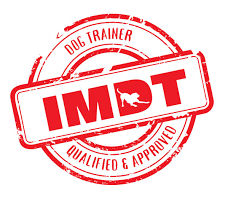Learn about Dog Anxiety. The possible reasons for your dog’s anxiety and what you can do to help your dog’s confidence grow.
Living with an anxious dog
Living with and supporting a fearful dog can be the most challenging, heart-breaking and rewarding
Living with and supporting a fearful dog can be the most challenging, heart-breaking and rewarding experience, all at once. Some dogs worry about specific things, like strange surfaces, sudden noises or men in hats. Other dogs seem to be nervous about everything the moment they step out of their home. And some dogs are constantly anxious every waking hour. Their fear seems irrational to us, but for our dogs the threat is very real. They are not pretending or making it up. The world can be a scary and overwhelming place for a whole host of reasons.
A very common cause of fear is lack of appropriate socialisation in the sensitive development period in puppyhood. Puppies should start their socialisation before 5 weeks of age and by 14 weeks should be familiar with and comfortable around a wide range of spaces, environments, surfaces, people of all ages, ethnicities, genders and looks, lots of different dogs and other animals.
They should get used to seeing the normal objects that they will experience in adulthood such as cars, bicycles and household machines, and various situations such as being handled by a vet or a groomer, riding in a car and caring space with dogs and people at a veterinary reception room. Dogs who have been deprived of this rich learning experience of what is normal and safe are likely to be fearful and distrustful for life. Of course, with therapy, management, patience and lots of loving support, a dog like this can still enjoy life, but he may never be a happy-go-lucky, care-free goofball.
The most valuable thing in the world for this dog is the sense of safety. Create that by letting the dog make choices about his safety whenever possible. This means not putting the dog in situations that are overwhelming, allowing him to approach novel or scary things at his own pace, without coercion or pressure. When possible, always stop or move out of the situation if your dog tells you with his body language that he is afraid.
The ultimate aim is to make your dog trust you and learn that you pay attention to what he is trying to tell you. You can always come back another time, but be sure that the intensity of the experience is lower or distance from the scary thing is greater. Create happy experiences in all situations where the dog is unsure or uneasy, this includes treats, play and affection.
Building Confidence
The first thing we do here at Royvon, when an anxious dog arrives to train with us, is to make them at ease. Let them explore and settle in without pressure. As soon as the dog is ready, we start a confidence-building programme that includes play, invitation to explore, opportunity to succeed through simple but fun training exercises, reinforcing and safe experiences, gentle touch and lots of happy movement.
We may teach some tricks with a clicker and yummy treats, do some agility or proprioception exercises or engage the dog’s fantastic sense of smell with some scent games.
Working With Fear
There are many great techniques out there, depending on the specific trigger, the severity of the fear, the tools available and the individual needs of the dog and owner. Some well recommended approaches are counter-conditioning and desensitisation, Behaviour Adjustment Training (BAT), Look-At-That game and “matwork”/capturing calmness.
A common misconception and a harmful belief is that you should never reward the dog when they show fear, as this would reinforce the fear. The fear is an emotion, not a behaviour, and as such is not subject to reinforcement in the same sense as behaviour. The behaviour that arises from fear however can be reinforced. But the key to working with fearful dogs is to address the emotions, because those emotions drive the undesirable behaviour, such as barking at the postman or urinating when greeting a stranger.
Working with emotions means changing how the dog feels about the scary thing. If each time the dog sees the scary neighbour’s child, a slice of cheese magically appears in front of his mouth, the dog will learn to associate the child with pleasant experience. Eventually, the dog will start thinking about the cheese each time he sees the child, wagging his tail and looking at you expectantly.
The best thing you can do for your fearful dog is to not give upon him and seek professional assessment and help. The transformation from an anxious dog to a confident, playful and curious dog is definitely the most beautiful wonder to experience.
Traumatic Experience
Sometimes dogs worry about something because of a scary experience in the past, particularly during one of the several sensitive development periods called “fear periods”, scattered across puppyhood and adolescence. A traumatic experience during this time might cast a long shadow of fear in the same context in future. This is why puppy and adolescent socialisation should be free of startling and scary experiences and new situations should be cheerful and rewarding. A scary experience can also cause fear of similar situations at any other point in life, but it is probably easier to “undo it”.
Tip: Identify the triggers that scare your dog one by one. If your dog is a puppy or an adolescent and suddenly becomes frightened of something he has experienced before without fear or if he barks in a new situation, don’t worry, this is perfectly normal. Calmly get your dog out of the situation and try again later. Next time, be sure to be cheerful and give the pup the time and space he needs. Don’t force it. Chances are he will succeed this time. Forcing your dog into a frightening experience may result in permanent fear or learned helplessness in adulthood. Use food, play, happy chattering and affection to make uneasy experiences rewarding.
If your dog is an adult, proceed as above. Be sure to allow your dog to say “no” and to respect his choice. Prepare to cope with scary situations by rehearsing them in mock training setups that are pressure-free and fun, for example mock vet examinations, visits to the vet clinic just to get a treat from the vet nurse and go back out.
Medical Issues
The first thing to do would be to chat to your vet and see if there may be any underlying medical problem. Brain and thyroid disease are some of the common causes of increased anxiety, but any painful condition can contribute to it. In older dogs, diseases that affect the nervous system and loss of hearing are also typically linked to increase in anxiety. Those medical causes should be ruled out or addressed before behavioural therapy is undertaken.
Some dogs may also have genetic predisposition to being more fearful. This doesn’t mean behavioural approach will not work, quite the opposite, but it does mean that the baseline predisposition to fear is always going to be here.





Leave A Comment